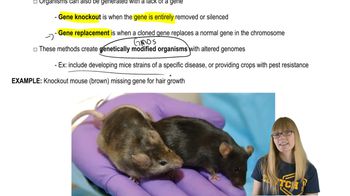Compare conservative, semiconservative, and dispersive modes of DNA replication.
Table of contents
- 1. Introduction to Genetics51m
- 2. Mendel's Laws of Inheritance3h 37m
- 3. Extensions to Mendelian Inheritance2h 41m
- 4. Genetic Mapping and Linkage2h 28m
- 5. Genetics of Bacteria and Viruses1h 21m
- 6. Chromosomal Variation1h 48m
- 7. DNA and Chromosome Structure56m
- 8. DNA Replication1h 10m
- 9. Mitosis and Meiosis1h 34m
- 10. Transcription1h 0m
- 11. Translation58m
- 12. Gene Regulation in Prokaryotes1h 19m
- 13. Gene Regulation in Eukaryotes44m
- 14. Genetic Control of Development44m
- 15. Genomes and Genomics1h 50m
- 16. Transposable Elements47m
- 17. Mutation, Repair, and Recombination1h 6m
- 18. Molecular Genetic Tools19m
- 19. Cancer Genetics29m
- 20. Quantitative Genetics1h 26m
- 21. Population Genetics50m
- 22. Evolutionary Genetics29m
8. DNA Replication
Overview of DNA Replication
Problem 7
Textbook Question
In Kornberg's initial experiments, it was rumored that he grew E. coli in Anheuser-Busch beer vats. (Kornberg was working at Washington University in St. Louis.) Why do you think this might have been helpful to the experiment?
 Verified step by step guidance
Verified step by step guidance1
Understand the context of Kornberg's experiments: Kornberg was studying DNA replication and required a source of nucleotides and enzymes to conduct his research. E. coli was a model organism used in these experiments.
Consider the composition of beer: Beer contains nutrients such as sugars, amino acids, and vitamins that can support the growth of microorganisms like E. coli. These nutrients create an ideal environment for bacterial growth.
Analyze the benefits of using beer vats: Beer vats are large-scale fermentation vessels designed to maintain optimal conditions for microbial growth, including temperature, aeration, and nutrient availability. This would have been advantageous for growing large quantities of E. coli needed for biochemical studies.
Relate this to Kornberg's needs: Kornberg required a robust and efficient system to grow E. coli in large amounts to extract enzymes like DNA polymerase for his experiments. Beer vats provided a practical solution for scaling up bacterial cultures.
Conclude the reasoning: Using beer vats likely helped Kornberg by providing a nutrient-rich and controlled environment for E. coli growth, facilitating the production of biological materials necessary for his groundbreaking research on DNA replication.
 Verified video answer for a similar problem:
Verified video answer for a similar problem:This video solution was recommended by our tutors as helpful for the problem above
Video duration:
1mPlay a video:
Was this helpful?
Key Concepts
Here are the essential concepts you must grasp in order to answer the question correctly.
E. coli as a Model Organism
E. coli is a widely used model organism in molecular biology due to its simple genetics, rapid growth, and well-understood physiology. Its ability to thrive in various environments makes it ideal for experiments aimed at understanding fundamental biological processes, such as DNA replication and gene expression.
Recommended video:
Guided course

Transgenic Organisms and Gene Therapy
Nutrient Sources in Microbial Growth
The growth medium is crucial for microbial experiments, as it provides essential nutrients that support cell growth and division. Using Anheuser-Busch beer vats could have offered a rich source of carbohydrates and other nutrients, potentially enhancing the growth rate and metabolic activity of E. coli, thus yielding more robust experimental results.
Recommended video:
Guided course

Cancer Characteristics
Controlled Experimental Conditions
Conducting experiments in a controlled environment, such as a beer vat, allows researchers to manipulate and monitor various factors affecting microbial growth. This control is vital for isolating specific variables, ensuring that the results are reliable and can be attributed to the experimental conditions rather than external influences.
Recommended video:
Guided course

Bacteriophage Life Cycle
Related Videos
Related Practice
Textbook Question
1089
views


